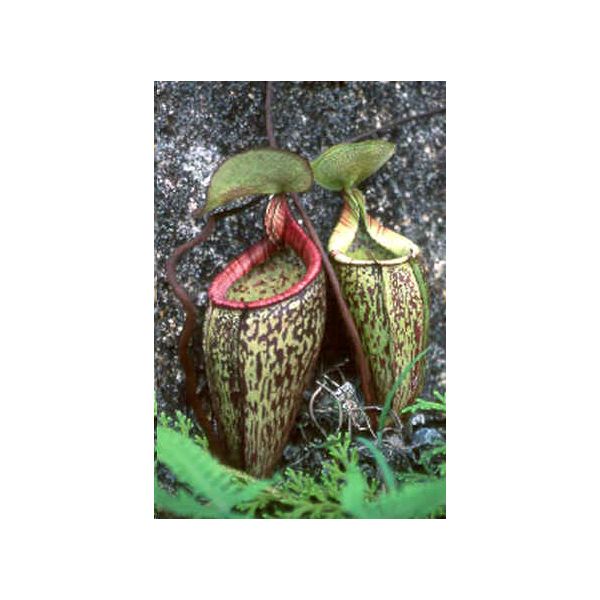Nepenthes Macfarlanei Seeds (Highland Nepenthes Seeds)
Nepenthes Macfarlanei Seeds (Highland Nepenthes Seeds)
This species is an easy grower that boasts beautiful, urn-shaped lower traps decoratively splashed with brown.

Delivery
All orders shipped with UPS Express.
Always free shipping for orders over US $250.
All orders are shipped with a UPS tracking number.
Returns
Items returned within 14 days of their original shipment date in same as new condition will be eligible for a full refund or store credit.
Refunds will be charged back to the original form of payment used for purchase.
Customer is responsible for shipping charges when making returns and shipping/handling fees of original purchase is non-refundable.
All sale items are final purchases.
Help
Give us a shout if you have any other questions and/or concerns.
Email: contact@domain.com
Phone: +1 (23) 456 789
Availability: Out of stock
SKU
Nepenthes Macfarlanei
Nepenthes Macfarlanei, also known as N.Hemsleyana Macfarl., or N. Hookeriana Low ex Becc. is native to the Peninsular Malaysia, Singapore, Borneo, and Sumatra. This species is an easy grower that boasts beautiful, urn-shaped lower traps decoratively splashed with brown.
NepenthesMacfarlanei is a carnivorous pitcher plant. It produces attractive red-speckled pitchers with a green lid. Lower pitchers are ovoid to cylindrical and up to 20 cm high. The lower surface of the lid is densely covered with short, white hairs. This is a characteristic morphological feature of this species, but at present its function is unknown.
Nepenthes Macfarlanei is a large, colorful plant. It has a wide range in Peninsular Malaysia and grows both terrestrially and as an epiphyte. The peristome is distinctively toothed, and the under surface of the lid is covered in long hairs. Pitcher morphology varies across the range of this plant, from squat, ovoid pitchers to narrower, oblong ones.
Hardiness zones:
11(4c/40f) N. Macfarlanei is an easy Nepenthes to grow, but is perhaps more sensitive to low humidity, or infrequent watering than some. As is generally true of highland Nepenthes species, it prefers a well-drained media, which usually includes a generous portion of long-fiber Sphagnum moss. Other soil ingredients may include peat moss, washed sand, horticultural charcoal, orchid bark and Osmunda fiber. Water daily and never let it sit in water. Highland Nepenthes require cool nights to grow well and form pitchers. They like to be kept humid. In general, night temperatures should drop below 60F nightly. Given cool nights, warm days well into the 80s or 90s are tolerated.
It can be considered an intermediate to highland plant, and as such more tolerant of warmer temperatures. Once established, it is an easy species to grow. Very small plants can tend to be difficult sometimes. Treat as a typical highland plant. This plant prefers live sphagnum moss. Nepenthes should be misted regularly in order to simulate the humidity of their natural habitat.
| Common name | Pitcher Plant |
|---|---|
| Species | Nepenthes macfarlanei |
| Germination | Nepenthes seeds should be started on chopped live sphagnum moss in very damp but not wet conditions. If the sphagnum starts to overgrow the seeds, pinch it back with a forceps. Sow the N. Macfarlanei seeds, on the surface, very sparingly. It is best to spray the sown seed with a fungicide to help keep the seeds from molding. Cover the pots or place them in plastic bags in warm, 32øC (90øF) plus temperatures. They should be in light shade or under fluorescent lights. Germination can take from 4 weeks to almost a year. Most seedling Nepenthes are lost soon after germination. For the best survival rate, transplant the seedlings on the week of germination. If transplanted with care and spaced about 1 to 2 cm apart in live sphagnum, fungus and desiccation problems are greatly reduced. Transplant the seedlings as they just begin to overgrow each other or their pots. Short day periods and cool temperatures are the most dangerous for the plants. Try to keep them warm and humid but not stagnant and wet. Watering and misting should be performed frequently, and preferably with distilled water, to avoid mineral build-up that is not only unsightly but that may damage the delicate roots of Nepenthes (and most other carnivorous plants). Standing water is inadvisable. A wet, well-draining potting medium is a necessity. Methods of feeding are varied - some growers feed freeze-dried bloodworms or Koi pellets (both available in the fish section of most pet stores); others prefer orchid mixes. No carnivorous plant should ever be fed mammalian meat - this will result not only in an unpleasant smell but also the probable rotting of the pitcher and potential death of the plant. The digestive enzymes present have not evolved to handle large prey items, and the rotting material gives opportunistic bacteria and fungi a chance to take hold. Germination can take longer. Be patient! |
| Price View | Price Range |

